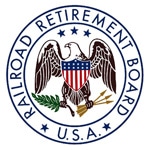
The Tier II tax rates are determined annually from a tax rate schedule based on an average account benefits ratio reflecting railroad retirement fund levels. Employer tax rates can range from 8.2 percent to 22.1 percent. Employee tax rates can range from 0 percent to 4.9 percent.
Experience Rating
In October 2015, each employer was sent a notice of their 2015 Railroad Unemployment Insurance Act (RUIA) contribution rate. If you have not received your notice, please contact the Quality Reporting Service Center.
Retirement and Survivor Benefits
Exempt Amounts for Annual Earnings Test for Less Than Full Retirement Age Annuitants: In 2016, the annual exempt amount for less than full retirement age annuitants is $15,720. The monthly exempt amount for the first year of retirement in 2016 is $1,310.
Exempt Amounts for Annual Earnings Test for Full Retirement Age Annuitants: In 2016, the annual exempt amount for full retirement age annuitants is $41,880. The monthly exempt amount for the first year of retirement in 2016 is $3,490.
No cost-of-living Increase: Annuitants will not receive a cost-of-living increase in 2016.
Unemployment and Sickness Benefits
Maximum Daily Benefit Rate: Under the Railroad Unemployment Insurance Act (RUIA), the maximum daily benefit rate is equal to 5 percent of the monthly RUIA compensation base, rounded down to the nearest multiple of $1.00. For days of unemployment and sickness in registration periods beginning on and after July 1, 2016, the maximum daily rate is $72.00. The maximum rate for registration periods beginning on or after July 1, 2017, is $72.00.
Monthly Compensation Base: The monthly compensation base under the Railroad Unemployment Insurance Act for calendar year 2016 is $1,455.
Qualifying Base Year Compensation: The amount of base year compensation required in 2016 to qualify for benefits in the benefit year beginning July 1, 2016, is $3,637.50.
Compensation of $3,637.50 is also the amount of creditable compensation required to end a voluntary leaving of work disqualification period in months in calendar year 2016. In addition, remuneration earned in calendar year 2016 from employment covered under the Act cannot be considered subsidiary remuneration if the employee’s base year earnings are less than $3,673.50.
Maximum Benefits: The monthly amount of base year 2016 compensation that can be counted in determining the maximum amount of normal benefits payable to an employee in the benefit year beginning July 1, 2017, is $1,879.
Maximum Monthly Compensation Base and the Earnings Test: For unemployment registration periods beginning July 1, 2017 and later, no benefits are payable for which the total amount of an employee’s earnings and other remuneration from railroad and non-railroad work for days in the period exceeds the monthly compensation amount of $1,455.
The 2016 railroad retirement tax rates and maximum compensation bases are as follows:
| Tax Type | Tax Rate | Earnings Base |
| Employee Medicare* | 1.45% | No limit |
| Employer Medicare* | 1.45% | No limit |
| Employee Tier I | 6.20% | $118,500 |
| Employer Tier I | 6.20% | $118,500 |
| Employee Tier II | 4.90% | $88,200 |
| Employer Tier II | 13.10% | $88,200 |
*Additional Medicare Tax: Employees will pay an additional 0.9 percent Medicare tax on earnings above $200,000 who file an individual return or $250,000 (for those who file a joint return). This additional Medicare tax rate is not reflected in the tax rates shown above.
Note: Medicare and Tier 1 Railroad Retirement tax rates are equivalent to Social Security tax rates set for 2016. Tier 2 Railroad Retirement tax rates do not apply to employees subject to Social Security.
Related News
- New CSX conductor improvises to save a life
- SMART News: Protecting Railroad Retirees’ Future
- More Than a Story: SMART-TD’s Women’s History Month Highlights Legacies in the Making
- Tentative Agreement Reached in Boston
- Assembly, No. 1672
- Historic short-line agreement proves workers are stronger with SMART-TD at their side
- SMART-TD’s Public Comment Opposing CSX’s “Zero-to-Zero” Push
- Like Mother, Like Daughter: New Jersey Transit is All in the Family for Rashonda Brown & Shakyia Ward
- DOGE to close seven RRB Regional Offices
- SB 25-162